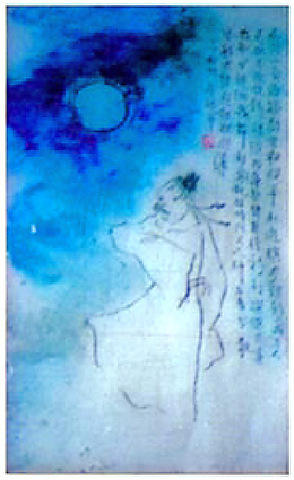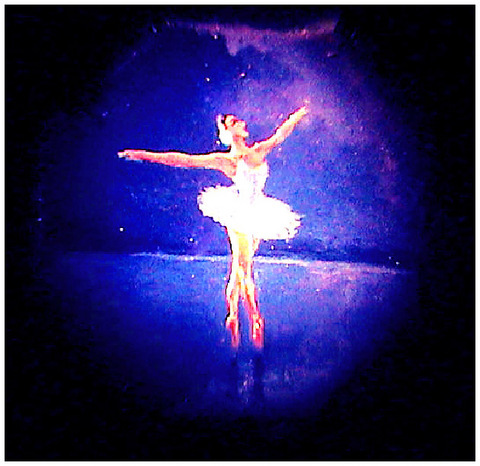I've never looked at Jin's micro-paintings or micro-carvings in person, and even if I had, I wouldn't have been able to see them -- not without a microscope. Even his biggest micro-painting, a group of portraits of the 42 US presidents on a single human hair, is less than 6mm long.
The Portraits of 42 American Presidents was completed last year in New York and holds the world record for most portraits in the smallest area. Somehow, Jin managed to give each president a vivid expression in a face with a diameter less than 0.4mm. Each face is distinct and recognizable.

Jin has created over 100 micro-paintings and carvings on different-colored hair, ivory and diamonds, and his works extend the traditional Chinese art of engraving and miniscule calligraphy.

PHOTOS COURTESY OF ARTIST:
In an e-mail interview, Jin explained that micro-painting has a long history in China and was done in pictographs on animal bones and tortoise shells. Jin called these Shang Dynasty inscriptions "the earliest mature writing" in China.
This writing, Jin said, was meant to evoke or explain the divine. As most people were illiterate, writing was of little help to the majority. In fact, it was the mystery of the inaccessible language that evoked the divine.
Today, micro-art creates hidden worlds similar to how carved pictographs created hidden worlds to populations of illiterates.
Jin has carved Tang Dynasty poems onto human hair, and his 1986 work Li Bai includes a Li Bai poem, beside a portrait of the poet in a white cloak under the moon -- all in a 3mm by 5.5mm area. Pine Trees in a Cloudy Valley (1985, 2x7.5mm), The Great Wall (1988, 3.5x6mm) and Flying Cloud (1986, 3x5.5mm) extend the Chinese landscape tradition, while Red Plum (1986, 3x6mm) is comparatively sparse and manages to contrast bright red petals on an ivory background through carving and painting.
Jin has extended traditional techniques of micro-carving and painting, too. He perfected a method called pomo in which minute amounts of ink are splashed onto the surface of ivory, usually about the size of a rice grain. Jin also uses more traditional tools, such as little brushes, inks and oils to paint.
Micro-painting is usually the medium he uses for his pop culture and Western-themed works, and he has also created micro-paintings of Asian and Middle Eastern heads of state. Elegant is a portrait on the width of a black hair and resembles Marilyn Monroe. Charlie Chaplain is about the same size and is painted on a white hair.
In the US and Europe, it's micro-painting, not micro-carving, that has found interest and applicability beyond pop culture icon renditions and pictures of president.
Micro-painting caught some attention during the West's modernist period, when American and European artists began to think of Asian art as something that could be applied to Western practice, not simply as something to gaze at with Orientalist thinking. Max Ernst's Micro-painting, at the Museum of Modern Art in New York is an example.
Micro-painting has also been practically applied in the area of making toys, trinkets, jewelry, models and game-pieces in the West, but China has been the hub of producing the items that are micro-painted and sent to the shelves of Western stores.
At the European company that produces Kinder Surprises -- tiny figures inside Easter eggs -- robots have taken over the painting of 23 million tiny figures, whose faces and details used to be painted by Chinese laborers. The robots are faster and paint with an accuracy within .01mm.
Micro-painting and micro-carving are still alive, well and centered in China, despite robotic competition. Jin separates his time between China and New York.
The world record for most characters in a micro-carving is held by Chinese artist?Xu Tonghai for, Selected Works of Mao Zedong, which includes 10,720,000 characters.

April 14 to April 20 In March 1947, Sising Katadrepan urged the government to drop the “high mountain people” (高山族) designation for Indigenous Taiwanese and refer to them as “Taiwan people” (台灣族). He considered the term derogatory, arguing that it made them sound like animals. The Taiwan Provincial Government agreed to stop using the term, stating that Indigenous Taiwanese suffered all sorts of discrimination and oppression under the Japanese and were forced to live in the mountains as outsiders to society. Now, under the new regime, they would be seen as equals, thus they should be henceforth

Last week, the the National Immigration Agency (NIA) told the legislature that more than 10,000 naturalized Taiwanese citizens from the People’s Republic of China (PRC) risked having their citizenship revoked if they failed to provide proof that they had renounced their Chinese household registration within the next three months. Renunciation is required under the Act Governing Relations Between the People of the Taiwan Area and the Mainland Area (臺灣地區與大陸地區人民關係條例), as amended in 2004, though it was only a legal requirement after 2000. Prior to that, it had been only an administrative requirement since the Nationality Act (國籍法) was established in

With over 80 works on display, this is Louise Bourgeois’ first solo show in Taiwan. Visitors are invited to traverse her world of love and hate, vengeance and acceptance, trauma and reconciliation. Dominating the entrance, the nine-foot-tall Crouching Spider (2003) greets visitors. The creature looms behind the glass facade, symbolic protector and gatekeeper to the intimate journey ahead. Bourgeois, best known for her giant spider sculptures, is one of the most influential artist of the twentieth century. Blending vulnerability and defiance through themes of sexuality, trauma and identity, her work reshaped the landscape of contemporary art with fearless honesty. “People are influenced by

The remains of this Japanese-era trail designed to protect the camphor industry make for a scenic day-hike, a fascinating overnight hike or a challenging multi-day adventure Maolin District (茂林) in Kaohsiung is well known for beautiful roadside scenery, waterfalls, the annual butterfly migration and indigenous culture. A lesser known but worthwhile destination here lies along the very top of the valley: the Liugui Security Path (六龜警備道). This relic of the Japanese era once isolated the Maolin valley from the outside world but now serves to draw tourists in. The path originally ran for about 50km, but not all of this trail is still easily walkable. The nicest section for a simple day hike is the heavily trafficked southern section above Maolin and Wanshan (萬山) villages. Remains of